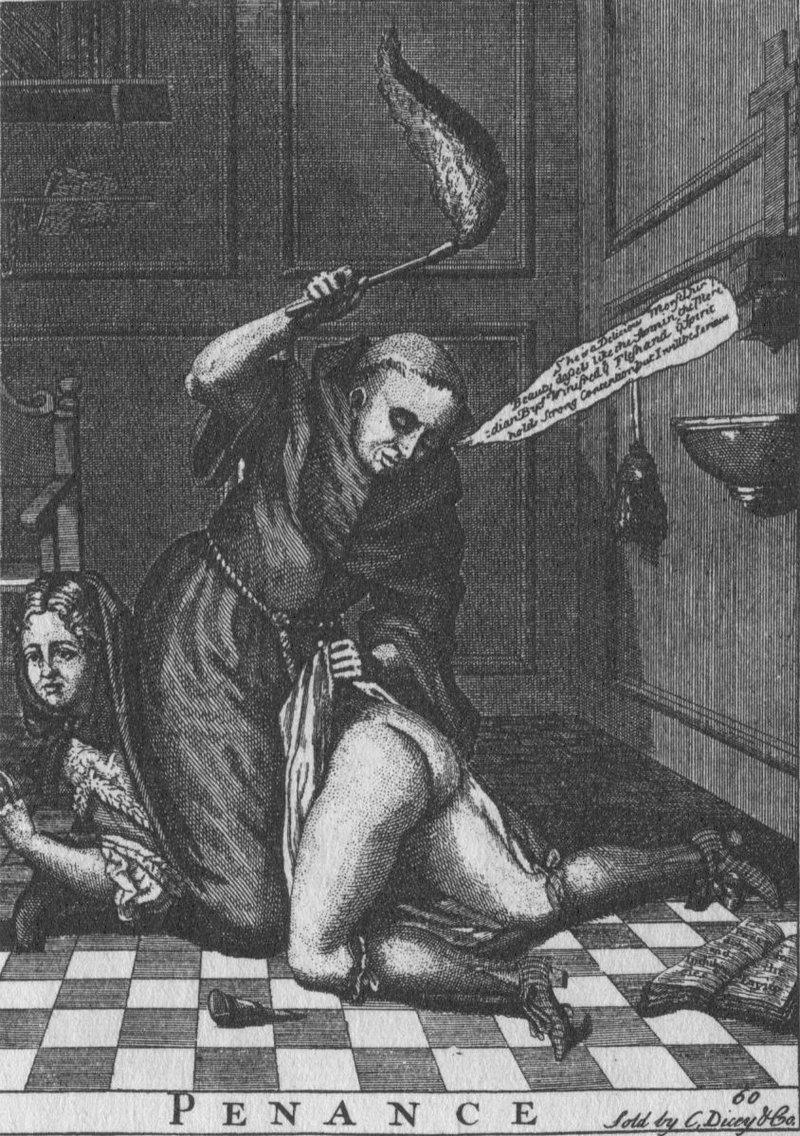Spanking Penance, The Big Version
Thanks to Ulrich-Dieter for sending along a much larger scan of the flogging penance woodcut from a few days ago:
If there’s anybody who is really good at reading and explaining obsolete English, the text balloon could use a better transcription than we have so far….






Close as I can make out:
She is a Delicious Morsel. Her
Beauty dazels like the Sunn in the Meridian Bris [breeze?].
Winifred in Flesh and in Spirit holds Strong Contention [i.e. is a strong argument], but I will be serious.
In the book:
Pardons and Indulgences for the Layity
This looks like an 18thc engraving.
Like Claire commented, that’s about the best I can make out of it as well – unfortunately it’s not brilliantly clear…
Claire has done about as well with this as I could; I can only contribute one emendation: it isn’t “in flesh..” etc. but “the flesh and the spirit hold strong contention” — i.e., I’m having a struggle between moral duty and carnal inclination (but I’ll be serious). The definite article before “flesh” and “spirit” is written “ye” with a small e over the y.
(Pedantic side note: This abbreviation was never pronounced “ye” as in “ye olde gifte shoppe.” The y stands for an obsolete scribal form of the letter g, which in very early English (and continuing much later in northern dialects including Scots) had the sound of y when it came before an e or an i. The old letter form, which looked like an elongated 3, disappeared when printing came along, because it wasn’t found in the type fonts that were first imported from the Continent. Y was the closest-looking letter, so printers used that for the abbreviation, and continued doing this into the 18th century. A similar case was “yt” for “that.”)
I’m sure the previous paragraph was of great interest to all spankophiles.
Getting back to the text in the picture, I’m puzzled by the words Claire rendered as “Bris [breeze?] and “Winifred.” I can’t do any better, though the first one looks as if it could be “Byet” — perhaps a kind of abbreviation for “but yet.” However, I’ve never run across such an abbreviation, so I’m not pushing it.
Oldguy
“By St. Winifred,” I believe. Here’s a website about the publisher, Dicey and Co.
http://www.bham.ac.uk/DiceyandMarshall/intro2.htm
Yes—St. Winifred makes perfect sense! She was a virgin who was almost raped but refused to submit, and consequently got herself beheaded and sainted. The monks of the church housing her shrine were granted the right to sell indulgences in the 15th c, which might account for the reference to Indulgences in the book on the floor. It might also be a sly reference to the political struggle between Catholics and Protestants in the 18thc.
Bravo to Oldguy for deciphering the definite article. Being a spanko can be educational! :-)
So in more modern parlance something like: “She is a delicious piece. Her beauty dazzles me like the sun at noon. (But) by St Winifred her flesh and spirit hold strong temptation but I will do my duty”
“By St. Winifred” sounds like the right stuff. I congratulate Doc on his (or her) learning, good eyesight, or superior monitor resolution — all three perhaps.
However, I’d suggest to Am (aka C./Confused) that when the cleric says “the spirit and the flesh hold strong contention” he means that a struggle between these opposing principles is taking place within himself. In other words, “my carnal desires are contending against my spiritual intention, but I’ll stick to my serious purpose” — i.e., inducing a true state of repentance in the erring maiden.
Oldguy
Oldguy – that’s basically what I meant – that he was struggling between the lure of her flesh and his duty to thrash her soundly… :)
Hey there, Am (aka C./Confused).
You’re certainly not confused about the general meaning of the speech. My point is really a pedantic one having to do with standard church language. Traditionally, when phrases like “the world, the flesh, and the devil” or “temptations of the flesh” or “weakness of the flesh” are used, they refer to the sinner’s (or potential sinner’s) very own flesh, this being a conventional metaphoric label for sexual desire rather than its object. So I believe the friar means that *his* flesh and *his* spirit are contending — even though *her* flesh is certainly an important part of the reason.
Anyhow, when you step back a couple of paces and take a broader view, the difference between our translations amounts to diddly-squat. Sometimes I just find it hard to put down my magnifying glass and take those couple of steps.
Oldguy
My God you all are the PhD’s of the spanking world!
I think the picture is ultra-hot.
It alludes to one of my all time favorite fantasies which is that of an
ordinarily good little girl who must be punished by her priest (or monk)
for pleasuring herself.
One can so easily imagine her begging, “I am so sorry Sir for pleasuring
my naughty pussy. Oh Sir, it is dripping wet! I am so very very sorry for being such a naughty naughty girl!
Delightful discussion.
Now, who’d care to attempt to identify the conical (not Canonical) object on the floor? Much too small for a dunce hat. If Bratscorcher’s correct in fantasizing that she’s being flogged for masturbation, did she use a deliciously ridged seashell as a dildo?
Oldguy – there’s nothing wrong with pedantry at all :) I’m happy enough to amicably debate the finer points of something for as long as all parties are content doing so. In this case, though, I think you definitely have the last word :)
A bell?
Highly unlikely that there would be an allusion to a young girl masturbating in a print of this period!
I am happy to have induced such a fruitful discussion about some words a monk has uttered in former times. By St. Winifred! May she lead us to more nice and warm bottoms inviting us and created for the whip!
Ulrich-Dieter
About the object on floor: If this is supposed to be a monk’s cell or a priest’s study, I suppose it might be an inkhorn, but in that case one would expect to see ink spilling out of it. (News flash: the ink used in pre-20th century pens was, until it was applied to paper or parchment, always liquid.) But it may have a hinged lid — one can see.
While examining the curious conical object, I noticed that the book lying on the floor says (reading down the first page and then down the second) something like “pardons [the end of this word isn’t clear to me] and indulgencies for the layity.”
It’s an oddly furnished location, whatever it’s supposed to be. On the wall there appears to be a holy water font of the kind one sees in the vestibule of a church, outside the door of the sanctuary — not the sort of place one would expect even the strictest of confessors to choose for a whipping.
Besides, floggers appear to be part of the furniture also. Notice that there’s another one hanging on the wall. It looks more like a duster than a flogger, but (unless the confessor interviews penitents in the janitor’s closet) that probably isn’t what it is. And the flogger he is wielding looks like it’s made of fluff instead of cords or leather thongs, as one might expect in a church “discipline.”
Most likely the English publisher didn’t have much information about Catholic clergy, other than the kind of hairdos and threads they favored. And their lustful habits, of course.
Oldguy
Just a correction to my last post: at the end of the first paragraph I left a sentence unfinished. It should say “But it may have a hinged lid — one can see a straight line cutting across one side of the circle, and that might be the hinge.”
I suppose that if the cleric had been at work writing about “pardons and indulgencies” when the naughty young lady arrived to confess, he might have closed his inkhorn, and then it might have fallen unnoticed to the floor during the ensuing penitential exercise.
Oldguy
Hi all – Hi Am,
Sorry – but I have to disagree about the translation. I can’t make out most of it, but I’m almost very certain that the last word or rather two words of the first line are Latin, and not English. I say this because I’m 95% sure the last word is “Diem”.
I’m just going to run some image enhancement over it now (this is getting serious!) :-)
Ok I give up (just spent 10 minutes flipping through a Latin dictionary). The best I can make out is MorfeDiem – which isn’t a word :(
Nadz – I’ve just thrown PSP at it – it does still look like serious to me (well, it actually looks like seriCus, but I think I los a bit of the o). I can shove it up on my blog if you’re interested – it’s actually come out almost legible!
Here is an exact transcription, with line divisions as in the original:
She is a delicious Morsel her
Beauty dassels like the Sunn in the Meri=
dian By St Winifred ye Flesh and ye Spirit hold
Sorry, wrong button. Here’s the complete comment.
Here is as close as I can come to an exact transcription, with line divisions as in the original:
She is a delicious Morsel her
Beauty dassels like the Sunn in the Meri=
dian By St Winifred ye Flesh and ye Spirit hold
strong Contention but I will be serious
In handwriting of that period (and sometimes in type also) the letter s, when not at the beginning of a line, was written in an elongated form that looks something like a lowercase f but without the crossbar. Funnily enough, when there are two s’s in a row, the second is written in the standard way (as in “dassels” in the second line).
It’s true that the l at the end of “Morsel” and the h at the beginning of the next word look (because of blurred reproduction) a bit like a capital D, but there isn’t any Latin here unless you count “meridian,” which is really a naturalized English word.
Oldguy
Well I stand corrected :-)
Thanks Am and O/G for clarifying that
A few people were commenting on the whip. It looks like it may be made of horsehair, possibly? But I guess with a lesser resolution it might look like “fluff.”
Hmm – well it’s either fluff or hasn’t been used yet at the time the picture was “taken” as there are no marks on her butt, which might’ve been used to try and identify the implement ..